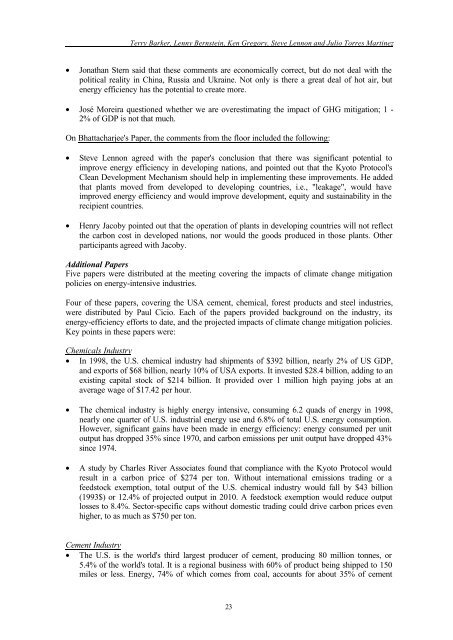sectoral economic costs and benefits of ghg mitigation - IPCC
sectoral economic costs and benefits of ghg mitigation - IPCC
sectoral economic costs and benefits of ghg mitigation - IPCC
Create successful ePaper yourself
Turn your PDF publications into a flip-book with our unique Google optimized e-Paper software.
Terry Barker, Lenny Bernstein, Ken Gregory, Steve Lennon <strong>and</strong> Julio Torres Martinez<br />
• Jonathan Stern said that these comments are <strong>economic</strong>ally correct, but do not deal with the<br />
political reality in China, Russia <strong>and</strong> Ukraine. Not only is there a great deal <strong>of</strong> hot air, but<br />
energy efficiency has the potential to create more.<br />
• José Moreira questioned whether we are overestimating the impact <strong>of</strong> GHG <strong>mitigation</strong>; 1 -<br />
2% <strong>of</strong> GDP is not that much.<br />
On Bhattacharjee's Paper, the comments from the floor included the following:<br />
• Steve Lennon agreed with the paper's conclusion that there was significant potential to<br />
improve energy efficiency in developing nations, <strong>and</strong> pointed out that the Kyoto Protocol's<br />
Clean Development Mechanism should help in implementing these improvements. He added<br />
that plants moved from developed to developing countries, i.e., "leakage", would have<br />
improved energy efficiency <strong>and</strong> would improve development, equity <strong>and</strong> sustainability in the<br />
recipient countries.<br />
• Henry Jacoby pointed out that the operation <strong>of</strong> plants in developing countries will not reflect<br />
the carbon cost in developed nations, nor would the goods produced in those plants. Other<br />
participants agreed with Jacoby.<br />
Additional Papers<br />
Five papers were distributed at the meeting covering the impacts <strong>of</strong> climate change <strong>mitigation</strong><br />
policies on energy-intensive industries.<br />
Four <strong>of</strong> these papers, covering the USA cement, chemical, forest products <strong>and</strong> steel industries,<br />
were distributed by Paul Cicio. Each <strong>of</strong> the papers provided background on the industry, its<br />
energy-efficiency efforts to date, <strong>and</strong> the projected impacts <strong>of</strong> climate change <strong>mitigation</strong> policies.<br />
Key points in these papers were:<br />
Chemicals Industry<br />
• In 1998, the U.S. chemical industry had shipments <strong>of</strong> $392 billion, nearly 2% <strong>of</strong> US GDP,<br />
<strong>and</strong> exports <strong>of</strong> $68 billion, nearly 10% <strong>of</strong> USA exports. It invested $28.4 billion, adding to an<br />
existing capital stock <strong>of</strong> $214 billion. It provided over 1 million high paying jobs at an<br />
average wage <strong>of</strong> $17.42 per hour.<br />
• The chemical industry is highly energy intensive, consuming 6.2 quads <strong>of</strong> energy in 1998,<br />
nearly one quarter <strong>of</strong> U.S. industrial energy use <strong>and</strong> 6.8% <strong>of</strong> total U.S. energy consumption.<br />
However, significant gains have been made in energy efficiency: energy consumed per unit<br />
output has dropped 35% since 1970, <strong>and</strong> carbon emissions per unit output have dropped 43%<br />
since 1974.<br />
• A study by Charles River Associates found that compliance with the Kyoto Protocol would<br />
result in a carbon price <strong>of</strong> $274 per ton. Without international emissions trading or a<br />
feedstock exemption, total output <strong>of</strong> the U.S. chemical industry would fall by $43 billion<br />
(1993$) or 12.4% <strong>of</strong> projected output in 2010. A feedstock exemption would reduce output<br />
losses to 8.4%. Sector-specific caps without domestic trading could drive carbon prices even<br />
higher, to as much as $750 per ton.<br />
Cement Industry<br />
• The U.S. is the world's third largest producer <strong>of</strong> cement, producing 80 million tonnes, or<br />
5.4% <strong>of</strong> the world's total. It is a regional business with 60% <strong>of</strong> product being shipped to 150<br />
miles or less. Energy, 74% <strong>of</strong> which comes from coal, accounts for about 35% <strong>of</strong> cement<br />
23
















